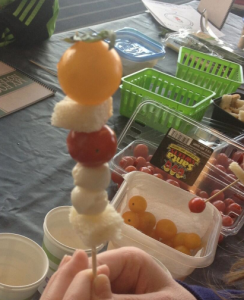I attended a fantastic meeting yesterday discussing ways to support healthy kids hosted by Let’s Move Pittsburgh. Any event at Phipps Conservatory and Botanical Gardens puts me in a good mood, but this topic is dear to my heart. I not a perfect parent but I do value resources that help me and my community raise healthy kids.
We heard inspiring information from Healthy Armstrong, a community partnership that has made great strides in the past ten years. But no one had any illusions about how much more needs to be done. As I listened to the excellent ideas Healthy Armstrong had implemented in schools to help kids eat healthy and be more active, like Monster Salads (who can resist eating a monster-faced salad), I had a specific question waiting.
“Did any parents object to these changes?”
“Yes,” our speaker acknowledged. “Ten years ago when we took fries on the menu, there was a boycott. But it’s not like that any more.”
I thought about my own school district where parents objected strongly to the removal of 400 calorie cookie from the snack items available for purchase at lunch. I thought about the subtle ways my school district has blocked concerned parents from working with school staff.
Other attendees noted that they’ve hosted events for parents to learn how to cook healthier, buy fresher food, eat better.
“No one comes,” they all agreed.
Why aren’t more parents willing to eat healthy?
At more that one school, parent groups will host fundraisers selling junk food items in an attempt to support the school. Our school district hosts a fundraiser that puts teachers behind the counter at a fast food restaurant and the school administrators actually called parents at home to encourage them to bring the children to buy food.
What are these activities teaching our kids?
Thankfully, some kids are learning the right messages and making changes on their own. Chef Mike from the City Charter school shared a moving story that showed kids may be the key to encourage parents to make some changes.
“We had a student who loved a menu item we made, and asked for the instructions. But I got an email from the parent saying ‘don’t send this home with my kid, I can’t afford these ingredients.’ Well, next time we did the menu item we showed the student how to make it and what to buy. He used money from his own part-time job to get the ingredients. He made it for his parent and the parent emailed me and said ‘thank you.’ They finally realized it wasn’t that bad.”
Let’s Move Pittsburgh focuses on children birth to age 8. That’s key because as Healthy Armstrong knows, even with their changes, 35% of kindergarteners come into school obese. Something needs to change at home.
Has your child ever inspired you to adopt a new healthy behavior?












